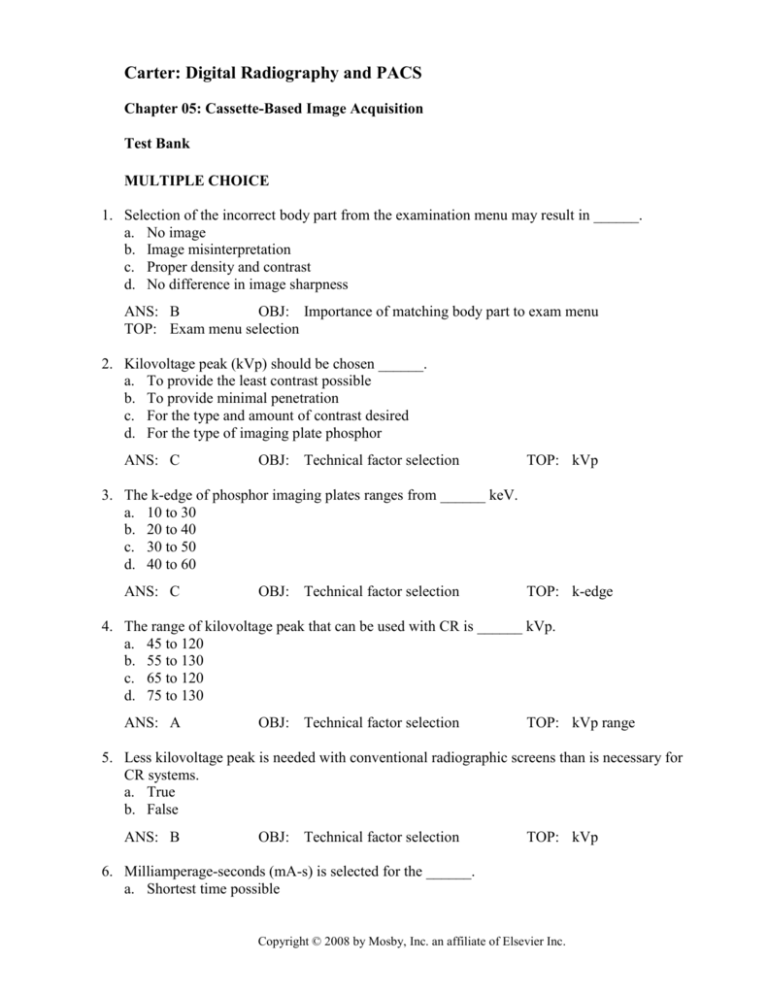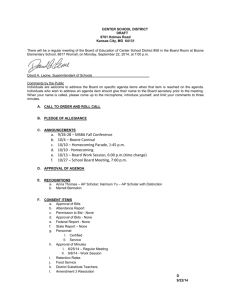Carter: Digital Radiography and PACS
advertisement

Carter: Digital Radiography and PACS Chapter 05: Cassette-Based Image Acquisition Test Bank MULTIPLE CHOICE 1. Selection of the incorrect body part from the examination menu may result in ______. a. No image b. Image misinterpretation c. Proper density and contrast d. No difference in image sharpness ANS: B OBJ: Importance of matching body part to exam menu TOP: Exam menu selection 2. Kilovoltage peak (kVp) should be chosen ______. a. To provide the least contrast possible b. To provide minimal penetration c. For the type and amount of contrast desired d. For the type of imaging plate phosphor ANS: C OBJ: Technical factor selection TOP: kVp 3. The k-edge of phosphor imaging plates ranges from ______ keV. a. 10 to 30 b. 20 to 40 c. 30 to 50 d. 40 to 60 ANS: C OBJ: Technical factor selection TOP: k-edge 4. The range of kilovoltage peak that can be used with CR is ______ kVp. a. 45 to 120 b. 55 to 130 c. 65 to 120 d. 75 to 130 ANS: A OBJ: Technical factor selection TOP: kVp range 5. Less kilovoltage peak is needed with conventional radiographic screens than is necessary for CR systems. a. True b. False ANS: B OBJ: Technical factor selection TOP: kVp 6. Milliamperage-seconds (mA-s) is selected for the ______. a. Shortest time possible Copyright © 2008 by Mosby, Inc. an affiliate of Elsevier Inc. b. Longest time possible c. Number of electrons needed d. Amount of penetration needed ANS: C OBJ: Technical factor selection TOP: mA-s 7. When insufficient light is produced by the imaging plate phosphor, the image will ______. a. Not be formed b. Be grainy c. Be dark d. Be detailed ANS: B OBJ: Technical factor selection TOP: Quantum mottle 8. Quantum mottle is caused by ______. a. Excessive milliampere-seconds b. Excessive kilovoltage peak c. Insufficient distance d. Insufficient light ANS: D OBJ: Technical factor selection TOP: Quantum mottle 9. Backscatter from the cassette/detector influences the amount of milliampere-seconds necessary to create the image. a. True b. False ANS: A OBJ: Technical factor selection TOP: AEC 10. Which of the following should be considered when selecting the CR cassette? a. Size and speed b. Type and speed c. Size and type d. None of these ANS: C OBJ: Imaging plate selection TOP: Imaging plate 11. Using an imaging plate that is much larger than the part being examined will ______. a. Increase resolution b. Decrease the size of the matrix c. Decrease the sampling rate d. Decrease resolution ANS: D OBJ: Imaging plate selection TOP: Imaging plate 12. Using the wrong imaging plate size may result in a matrix with very small pixels. a. True b. False ANS: B OBJ: Imaging plate selection TOP: Imaging plate Copyright © 2008 by Mosby, Inc. an affiliate of Elsevier Inc. 13. The higher the number of pixels in a matrix, the ______. a. Higher the image resolution b. Lower the image resolution c. Lack of effect on image resolution d. Smaller the image ANS: A OBJ: Image matrix TOP: Matrix 14. Grid lines projected onto the imaging plate will not interfere with the image. a. True b. False ANS: B OBJ: Describe the grid selection process. TOP: Grid selection 15. The moiré artifact results when grid lines and scanning laser are ______. a. Not perpendicular b. Not parallel c. Parallel d. Oscillating ANS: B OBJ: Describe the grid selection process. TOP: Grid selection 16. Grid use for CR examinations is more critical than in film/screen radiography because CR ______. a. Examinations produce more scatter b. Imaging plates record more densities c. Imaging plates record less scatter d. Examinations requires much higher kilovoltage peak values ANS: B OBJ: Describe the grid selection process. TOP: Grid selection 17. The number of grid lines per centimeter or lines per inch describes grid ______. a. Frequency b. Ration c. Focus d. Size ANS: A OBJ: Describe the grid selection process. TOP: Grid selection 18. Grid ratio describes the ______. a. Number of grid lines per centimeter or lines per inch b. Angling of the lead strips to coincide with x-ray beam diversion c. Relationship between the height of the lead strips to the interspace d. Physical size of the grid to be used for each distance measured ANS: C OBJ: Describe the grid selection process. TOP: Grid selection Copyright © 2008 by Mosby, Inc. an affiliate of Elsevier Inc. 19. Which of the following require more critical beam centering? a. Parallel grids b. Focused grids c. Low-ration grids d. Low-frequency grids ANS: B OBJ: Describe the grid selection process. TOP: Grid selection 20. Collimation to a smaller area ______. a. Increases scatter b. Increases amount of tissue irradiated c. Decreases resolution d. Decreases Compton interactions ANS: D TOP: Collimation OBJ: Discuss the importance of preprocessing collimation. 21. Shuttering, a postexposure image manipulation technique, is ______. a. Placed on the patient b. Placed on the cassette c. Added to the screen image d. Changes the amount of scatter ANS: C TOP: Collimation OBJ: Discuss the importance of preprocessing collimation. 22. It is acceptable to replace collimation with shuttering. a. True b. False ANS: B TOP: Collimation OBJ: Discuss the importance of preprocessing collimation. 23. Images should be marked only with computerized markers. a. True b. False ANS: B OBJ: Discuss the importance of patient side markers. TOP: Side markers 24. A technologist can lend credibility to his or her expertise by ______. a. Using a grid b. Using personal position markers c. Using less collimation d. None of the above ANS: B OBJ: Discuss the importance of patient side markers. TOP: Side markers Copyright © 2008 by Mosby, Inc. an affiliate of Elsevier Inc. 25. The exposure indicator number is an ______. a. Accurate measure of the patient dose b. Indication of radiation absorbed by the imaging plate c. Both A and B d. Neither A nor B ANS: B OBJ: Compare exposure indicators for major manufacturers. TOP: Exposure indicator number 26. The exposure indicator number for Fuji systems is the ______ number. a. S b. EI c. lgM d. EM ANS: A OBJ: Compare exposure indicators for major manufacturers. TOP: Exposure indicator number 27. The EI number is used by ______. a. Fuji b. Philips c. Konica d. None of the above ANS: D OBJ: Compare exposure indicators for major manufacturers. TOP: Exposure indicator number 28. A 1 mR exposure at 80 kVp combined with aluminum and copper filtration determines the ______ base exposure indicator number. a. Fuji b. Kodak c. Agfa d. Phillips ANS: B OBJ: Compare exposure indicators for major manufacturers. TOP: Exposure indicator number 29. With Fuji exposure indicators, the lower the S number, the higher the exposure. a. True b. False ANS: B OBJ: Compare exposure indicators for major manufacturers. TOP: Exposure indicator number 30. Which of the following manufacturers uses exposure indicator numbers in the thousands? a. Konica b. Phillips c. Fuji d. Kodak ANS: D OBJ: Compare exposure indicators for major manufacturers. Copyright © 2008 by Mosby, Inc. an affiliate of Elsevier Inc. TOP: Exposure indicator number 31. As Kodak exposure indicator numbers increase by 300, exposure ______. a. Increases by a factor of 2 b. Decreases by a factor of 4 c. Increases by a factor of 4 d. Decreases by a factor of 2 ANS: A OBJ: Compare exposure indicators for major manufacturers. TOP: Exposure indicator number 32. An S number of 400 in a Fuji system ______ an S number of 200. a. Is double the exposure of b. Equals the exposure c. Is half the exposure of d. Does not relate to ANS: C OBJ: Compare exposure indicators for major manufacturers. TOP: Exposure indicator number 33. In a Fuji system, each change of exposure number of 200 is equal to a change by a factor of ______. a. 2 b. 3 c. 4 d. 5 ANS: A OBJ: Compare exposure indicators for major manufacturers. TOP: Exposure indicator number 34. In an Agfa system, each change of 2.6 above or below the median exposure results in a doubling or halving of exposure. a. True b. False ANS: B OBJ: Compare exposure indicators for major manufacturers. TOP: Exposure indicator number 35. In all systems, exposures outside the range indicate ______. a. Overexposure b. Underexposure c. Both overexposure and underexposure d. Neither overexposure nor underexposure ANS: C OBJ: Compare exposure indicators for major manufacturers. TOP: Exposure indicator number 36. A histogram is ______. a. An examination of the chest b. A graphic representation of x-ray exposure Copyright © 2008 by Mosby, Inc. an affiliate of Elsevier Inc. c. A report on exposure values d. Another name for exposure indicator value ANS: B TOP: Histogram OBJ: Image data recognition and preprocessing 37. Kodak describes image recognition as ______. a. Collimation b. Segmentation c. Exposure data recognition d. Characteristic curve ANS: B OBJ: Image data recognition and preprocessing TOP: Exposure data recognition 38. In automatic data recognition in Fuji systems, ______ is automatically recognized. a. Collimation b. Image recoding range c. Reading latitude d. All of the above ANS: D TOP: Histogram OBJ: Image data recognition and preprocessing 39. In automatic data recognition, data is recognized ______. a. In a zigzag pattern b. In a parallel, vertical pattern c. From the center out d. From the edges in ANS: C OBJ: Image data recognition and preprocessing TOP: Automatic data recognition 40. The latitude value of the histogram is fixed, using a small reading area in ______ mode. a. Fixed b. Multiple manual c. Automatic d. Semiautomatic ANS: D OBJ: Image data recognition and preprocessing TOP: Automatic data recognition 41. The data recognition mode in which there is no histogram analysis is the ______ mode. a. Fixed b. Multiple manual c. Automatic d. Semiautomatic ANS: A OBJ: Image data recognition and preprocessing TOP: Automatic data recognition Copyright © 2008 by Mosby, Inc. an affiliate of Elsevier Inc. 42. Dark line artifacts can be caused by ______. a. Dirt on the light guide in the plate reader b. Double exposure c. Cracks in the imaging plate d. Scatter through the back of the cassette ANS: D TOP: Artifacts OBJ: Image data recognition and preprocessing 43. Horizontal white lines may be caused by ______. a. Dirt on the light guide in the plate reader b. Double exposure c. Cracks in the imaging plate d. Scatter through the back of the cassette ANS: A TOP: Artifacts OBJ: Image data recognition and preprocessing 44. To avoid the moiré grid artifact, the grid must be oriented ______ to the plate reader’s laser scan direction. a. Perpendicular b. Parallel c. Superior d. Inferior ANS: B TOP: Artifacts OBJ: Image data recognition and preprocessing 45. Fine white lines appearing on a hard copy of the image may be caused by ______. a. Dirt on the light guide in the plate reader b. Double exposure c. Cracks in the imaging plate d. Debris on the mirror in the laser printer ANS: D TOP: Artifacts OBJ: Image data recognition and preprocessing Copyright © 2008 by Mosby, Inc. an affiliate of Elsevier Inc.








